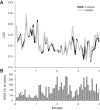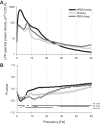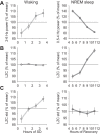Lempel-Ziv complexity of cortical activity during sleep and waking in rats
- PMID: 25717159
- PMCID: PMC4416627
- DOI: 10.1152/jn.00575.2014
Lempel-Ziv complexity of cortical activity during sleep and waking in rats
Abstract
Understanding the dynamics of brain activity manifested in the EEG, local field potentials (LFP), and neuronal spiking is essential for explaining their underlying mechanisms and physiological significance. Much has been learned about sleep regulation using conventional EEG power spectrum, coherence, and period-amplitude analyses, which focus primarily on frequency and amplitude characteristics of the signals and on their spatio-temporal synchronicity. However, little is known about the effects of ongoing brain state or preceding sleep-wake history on the nonlinear dynamics of brain activity. Recent advances in developing novel mathematical approaches for investigating temporal structure of brain activity based on such measures, as Lempel-Ziv complexity (LZC) can provide insights that go beyond those obtained with conventional techniques of signal analysis. Here, we used extensive data sets obtained in spontaneously awake and sleeping adult male laboratory rats, as well as during and after sleep deprivation, to perform a detailed analysis of cortical LFP and neuronal activity with LZC approach. We found that activated brain states-waking and rapid eye movement (REM) sleep are characterized by higher LZC compared with non-rapid eye movement (NREM) sleep. Notably, LZC values derived from the LFP were especially low during early NREM sleep after sleep deprivation and toward the middle of individual NREM sleep episodes. We conclude that LZC is an important and yet largely unexplored measure with a high potential for investigating neurophysiological mechanisms of brain activity in health and disease.
Keywords: Lempel-Ziv complexity; local field potentials; neuronal activity; rats; sleep.
Copyright © 2015 the American Physiological Society.
Figures








References
-
- Abásolo D, Hornero R, Gomez C, Garcia M, Lopez M. Analysis of EEG background activity in Alzheimer's disease patients with Lempel-Ziv complexity and central tendency measure. Med Eng Phys 28: 315–322, 2006. - PubMed
-
- Achermann P, Dijk DJ, Brunner DP, Borbely AA. A model of human sleep homeostasis based on EEG slow-wave activity: quantitative comparison of data and simulations. Brain Res Bull 31: 97–113, 1993. - PubMed
-
- Amigo JM, Szczepanski J, Wajnryb E, Sanchez-Vives MV. Estimating the entropy rate of spike trains via Lempel-Ziv complexity. Neural Comput 16: 717–736, 2004. - PubMed
-
- Arnold MM, Szczepanski J, Montejo N, Amigo JM, Wajnryb E, Sanchez-Vives MV. Information content in cortical spike trains during brain state transitions. J Sleep Res 22: 13–21, 2012. - PubMed
-
- Bjornsson CS, Oh SJ, Al-Kofahi YA, Lim YJ, Smith KL, Turner JN, De S, Roysam B, Shain W, Kim SJ. Effects of insertion conditions on tissue strain and vascular damage during neuroprosthetic device insertion. J Neural Eng 3: 196–207, 2006. - PubMed
Publication types
MeSH terms
Grants and funding
LinkOut - more resources
Full Text Sources
Other Literature Sources

